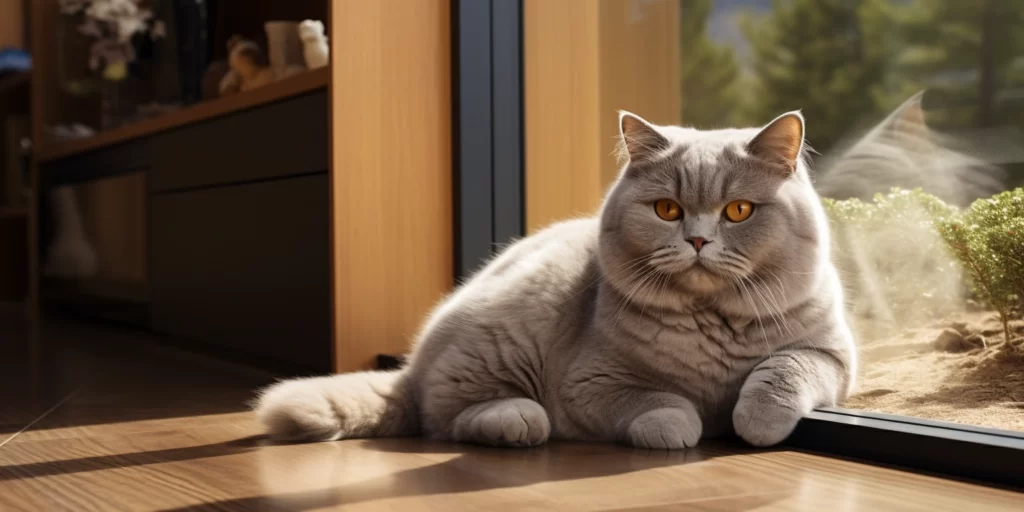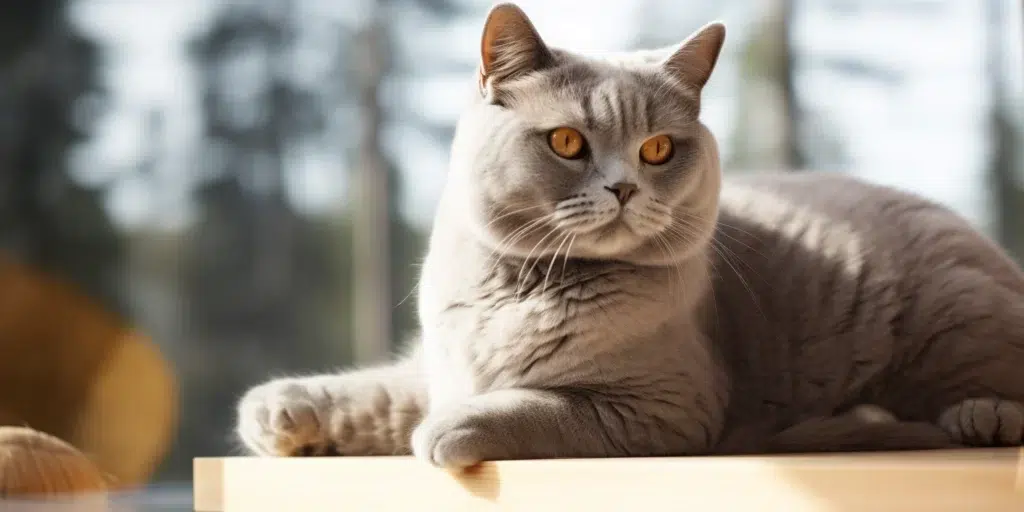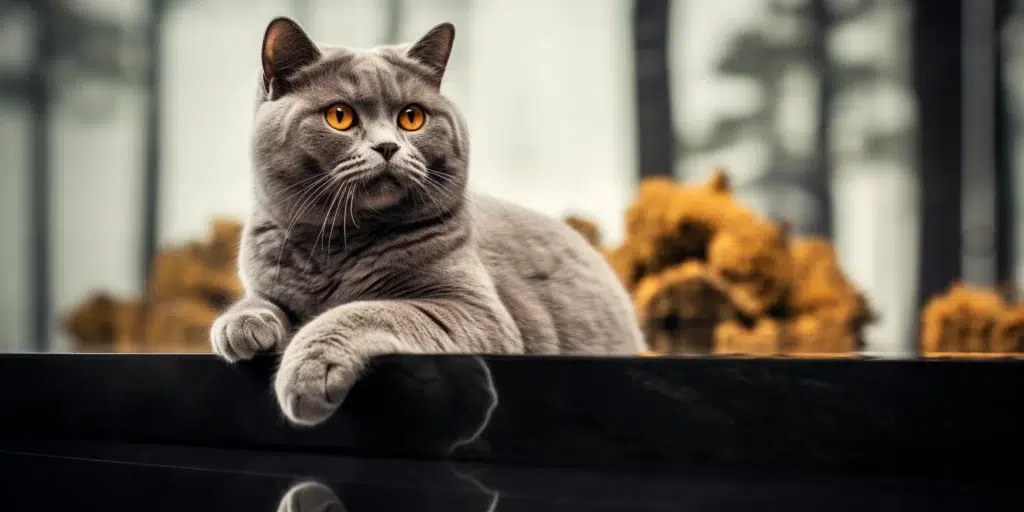As the new year unfolds, many families and individuals are considering adding a furry friend to their home. The lovable British Shorthair, with its plush coat and cherubic eyes, stands out as a particularly charming choice for many cat enthusiasts. This breed’s popularity is on the rise, and rightly so, considering its calm demeanor and affectionate nature.
However, like any pet adoption, prospective British Shorthair owners often wonder: How much will it cost? In this blog, we will discuss initial purchase costs, care costs, and ways to budget for this delightful breed in 2024.
- How Much Does a British Shorthair Kitten Cost?
- Other Factors That Influence the Purchase Price of a British Shorthair
- Initial Setup and Supplies Cost for a British Shorthair
- The Ongoing Medical Expenses for the British Shorthair
- The Ongoing Food and Supplies Cost Of A British Shorthair
- How Much Does It Cost to Insure a British Shorthair?
- Additional Costs
- How To Save On The Ongoing Cost of Owning A British Shorthair
- How To Get a British Shorthair on a Budget!
- Conclusion

How Much Does a British Shorthair Kitten Cost?
The cost of a British Shorthair cat can be quite varied, depending on a host of factors. One cannot simply put a fixed price tag on these feline charmers. Variables such as pedigree, breeder reputation, and even the cat’s color can heavily influence the cost. Here are three main factors influencing the initial cost:
Gender plays a role in pricing kittens. Male cats, particularly those intended for breeding or show purposes, may be priced higher than females due to their potential to sire offspring with desirable traits.
However, for those looking for a family pet rather than a show participant or breeder, this price difference may be less pronounced.
Color is another factor that can affect the price of a British Shorthair. Colors like blue and silver tabby, which are very rare and desirable, tend to command a premium, while more common colors tend to be more affordable. This is not specific to the British Shorthair breed, but is true of all purebred cats.
Genetics is a significant factor in determining price. Kittens from award-winning lines or those with an exceptional pedigree can command higher prices due to the desirable traits they are expected to inherit from their ancestors. Health clearances and genetic tests performed on the parents can also add to the value (and hence price) of their offspring.
One thing is certain: regardless of gender, color, or genetics, a well-bred British Shorthair kitten is an investment. They bring companionship, joy, and even a touch of royalty (given their lineage traces back to England’s traditional domestic cats) to any home.
Other Factors That Influence the Purchase Price of a British Shorthair
Beyond the initial considerations of gender, color, and genetics, several other factors play into how much you can expect to spend on a British Shorthair.
Age of The British Shorthair
Age can influence price because kittens generally cost more due to their increased demand. Older cats might be less expensive but consider that adopting an adult cat means potentially missing out on some formative early experiences and bonds.
Quality Of The Breed
“Quality” refers to how well a cat conforms to breed standards. A “show quality” kitten—one that is deemed fit for cat shows—will likely be more expensive than a “pet quality” one, which may have minor cosmetic discrepancies that do not affect its health or vitality.

Pattern, Color, Body Shape
These physical traits can affect pricing as well. Aesthetic traits like unique patterns or colors often attract higher prices. Similarly, an exemplary body form that fits the British Shorthair standard tightly can increase a kitten’s value.
Genetics & Health of The Cat
Kittens with verifiable health clearances and those from lines with known health histories may be valued higher. Breeding cats is expensive when done ethically (including genetic testing), and breeders will charge more for kittens without genetic predispositions to certain diseases.
Availability of The Cat in Your Area
If you live in an area where British Shorthairs are rare, you might find prices are higher due to scarcity. Conversely, if there are many breeders nearby, competition might lower the cost.
Initial Setup and Supplies Cost for a British Shorthair
The investment in a British Shorthair kitten only begins with the purchase price. Here’s a breakdown of initial setup and supplies costs you can expect:
| Type of Cost | Dollar Amount $ |
|---|---|
| Spay/Neuter: | $50 – $500 |
| Vet Exam and Shots: | $50 – $100 per visit |
| Microchip (recommended): | $45 – $60 |
| Cat Bed: | $20 – $50 |
| Nail Clipper (optional): | $5 – $15 |
| Brush (optional): | $10 – $30 |
| Litter Box: | $15 – $50 |
| Litter Scoop: | $1 – $10 |
| Toys: | $5 – $50 |
| Food and Water Bowls: | $5 – $20 |
The actual costs will depend on your choices regarding quality and brand, but these are essential to ensure your British Shorthair’s comfortable transition into their new home.

The Ongoing Medical Expenses for the British Shorthair
After bringing home your British Shorthair kitten, medical expenses are a continuous aspect of pet care. Vaccinations are critical early on and throughout your cat’s life to protect against common diseases.
Regular vet checkups are also crucial in monitoring your cat’s health and catching any potential problems early. Even healthy cats should visit the vet at least once per year.
Medicines for any diagnosed condition can greatly vary in cost. Predicting this expense isn’t always easy as it depends on individual cats’ health needs which emerge over time. It’s essential to budget accordingly in case your pet requires medical attention beyond routine care.
Flea and tick prevention is another ongoing cost not to be overlooked, as it’s an important part of keeping your British Shorthair healthy and comfortable.
The Ongoing Food and Supplies Cost Of A British Shorthair
Feeding your British Shorthair high-quality food is an ongoing expense that contributes to their overall well-being. While higher-quality foods may carry a higher price tag upfront, they could potentially save you money on veterinary bills due to poor nutrition-related health issues.
There are other recurring expenses, such as cat litter (the price of which can vary greatly), dental care (at the vet’s office or with at-home kits), and the replacement of worn-out items like beds and toys. It is a good idea to replace old supplies on a regular basis, both for sanitary reasons and to provide mental and physical stimulation for your cat.
How Much Does It Cost to Insure a British Shorthair?
Insurance for a British Shorthair is an option that could save you money in case of unexpected health issues or accidents. Policies vary widely in what they cover and how much they cost, so it will require some research based on your individual needs and what risks you want to insure against.
Typically, insurance premiums will be influenced by the age of your cat, any pre-existing conditions they may have, and even where you live. It’s beneficial to weigh the monthly or yearly premiums against potential vet costs you could face without insurance.

Additional Costs
Just like any other kind of cat, owning a British Shorthair can have extra expenses that you might not notice at first glance. Cats are known to be very playful and inquisitive, so it is not uncommon for them to climb curtains or scratch sofas for fun.
An often overlooked expense is carpet cleaning; depending on how much shedding your British Shorthair does (they tend to have dense coats that shed seasonally), keeping your house fur-free can require frequent vacuuming or professional services.
Pet sitting services during vacations or long workdays add another cost if you don’t have friends or family able to help out. Lint or hair rollers for clothing are likely going to be needed unless you don’t mind wearing your cat’s fur color as an accessory!
Last but not least, accidents can occur; for example, if your shoes or clothes are somewhat chewed, you might have to spend money on accidental shopping trips.
How To Save On The Ongoing Cost of Owning A British Shorthair
While some expenses are fixed, there are ways you can cut down on costs without compromising on care for your cherished British Shorthair. Buying food in bulk often leads to savings per unit; just be sure you have appropriate storage to keep it fresh.
You can save money in the long run by buying more litter; however, you should keep in mind that it needs to be stored properly to keep its effectiveness. Before buying any other supplies or treats for your cat, it is a good idea to shop around and compare prices. You can sometimes find better deals online than in physical stores.
Making toys for your cat or homemade treats is not only budget-friendly but can also provide an enrichment activity for both you and your pet; there are countless DIY toy tutorials available online suitable even for those who aren’t particularly crafty.
The cost of long-term medical care for your pet, including any unanticipated procedures or prescriptions, can quickly pile up, so it is a good idea to get pet insurance.
How To Get a British Shorthair on a Budget!
If you want a British Shorthair but do not have the money, do not worry; there are still ways to bring one into your home without breaking the bank. Consider adopting from shelters or rescue groups; while pure breeds are not always common in these settings, they do occasionally appear, and adoption fees are usually lower than those charged by breeders.
Platforms like Craigslist, Kijiji, or Facebook Marketplace sometimes have listings from owners looking to re-home their pets for various reasons—just be cautious about ensuring such transactions are legitimate and that the cats have been well cared for.
Community posting boards at local pet stores or vet offices may also lead you to affordable possibilities; however, keep in mind that while these may be less expensive ways to ownership at first, they still come with all of the fees associated with caring for a British Shorthair.

Conclusion
In totality, acquiring and maintaining ownership of a British Shorthair involves comprehensive costs which include but are not limited to initial purchase price or adoption fees. The long-term commitment encompasses ongoing care costs like medical expenses food supplies occasional replacements due to wear tear or playful mishaps even insurance if chosen.
While there are methods by which prospective owners can mitigate some expenses, remember that owning a pet is a life-changing decision, both emotionally and financially. Consider these factors carefully before welcoming British Shorthair into your life. With proper planning and love support, these cherubic beings will provide years of feline friendship loyalty, making every penny spent a truly worthwhile investment in joy companionship.